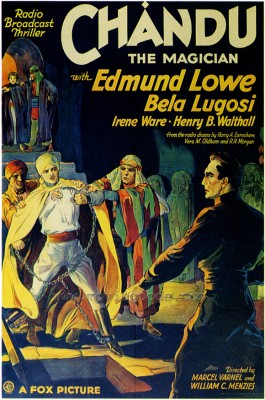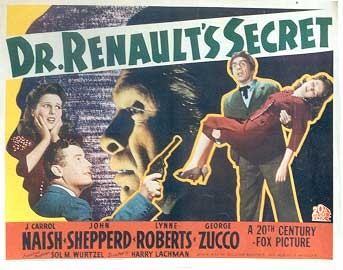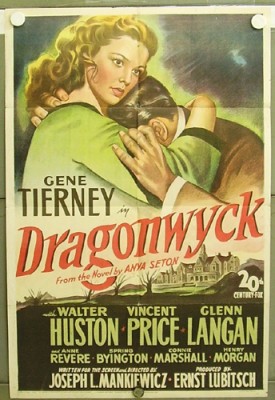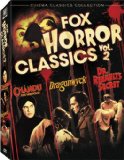| Reviews & Columns |
|
Reviews DVD TV on DVD Blu-ray 4K UHD International DVDs In Theaters Reviews by Studio Video Games Features Collector Series DVDs Easter Egg Database Interviews DVD Talk Radio Feature Articles Columns Anime Talk DVD Savant Horror DVDs The M.O.D. Squad Art House HD Talk Silent DVD
|
DVD Talk Forum |
|
|
| Resources |
|
DVD Price Search Customer Service #'s RCE Info Links |
|
Columns
|
|
|
Fox Horror Classics, Vol. 2 (Chandu the Magician / Dr. Renault's Secret / Dragonwyck)
No more a horror film than Raiders of the Lost Ark, Chandu the Magician is a fantasy-adventure with science fiction elements, done in the style of a high class serial. Though Hollywood made its share of early talkies set in the exotic Middle and Far East, nothing really comes close to matching the look of this unique film, and the lion's share of the credit squarely falls in the hands of its famed co-director/production designer and its cinematographer, William Cameron Menzies (Things to Come, Invaders from Mars) and James Wong Howe (Hud), respectively.
When inventor Robert Regent (Henry B. Walthall) is kidnapped by megalomaniacal super-villain Roxor (Bela Lugosi), who covets the secret of Regent's destructive death ray, it's up to Regent's brother-in-law Frank Chandler (Edmund Lowe) to rescue him. Chandler is up to the challenge: a bona fide yogi newly christened Chandu, the former army officer is now a full-fledged mystic, a magician with supernatural powers including astral projection, the ability to walk through fire unscorched, mesmerize even the strongest-willed opponents, teleport from place to place, and create strange but lifelike apparitions.
Seemingly equal parts of H. Rider Haggard, Flash Gordon, and One Thousand and One Nights (and visually quite similar to Carl Barks's later Uncle Scrooge comic books), the 71-minute film is fast-paced and visually sumptuous. Menzies's super-stylized sets are really something to see, similar to those he built for the 1924 Thief of Bagdad; some may even be left over from that film. The picture is crammed with impressive visual effects, an inspired collaboration between Menzies and Howe, including numerous miniature lost temples, some impressive tracking shots through (again, miniature) catacombs and corridors, matte paintings and optical effects. Near the end there's even an audacious attempt to stage an underwater sequence on a dry set that Menzies almost pulls off.
According to the IMDb, Chandu the Magician cost $349,456 to produce, and earned $488,496 in U.S. rentals. That sounds about right, and what it means is that while the picture didn't have a huge budget, by 1932 standards it was well above average, a smallish A-picture one, and Menzies and Howe make it look even more expensive than it was.
Edmund Lowe was a good actor whose career in films stretched nearly half a century, from at least 1915 to 1960's Heller in Pink Tights (bad movie, though Lowe was excellent). He's really out of his element in this, lacking the charisma the part calls for. (It's hard to imagine who'd have been better; maybe a Ricardo Cortez or Adolphe Menjou type.) Conversely, Bela Lugosi delivers one of the ripest performances of his Hollywood career, in a career full of some pretty wild theatrics. Near the end he delivers a raving monologue ("They shall bow be-fore me in waar-ship!") so over the top you expect his eyes to pop out of their sockets on springs like little Jack-in-the-boxes. Many have accused Lugosi of unbridled hamminess, but there's no denying his is by far Chandu's most entertaining performance. (*** 1/2)
Originally one-half of a double-bill supported by the decidedly more tasteful and atmospheric The Undying Monster (included in Volume 1), Dr. Renault's Secret plays very much like a really classy Monogram or PRC horror movie. It's even got genre veterans (if not quite stars) J. Carrol Naish and George Zucco; both knew their way around this kind of material but usually had to content themselves which much less splendiferous surroundings.
A young American scientist, Dr. Larry Forbes (billed as John Shepperd, but immediately recognizable as Shepperd Strudwick, later a prolific television actor), visits a small French village to reunite with his fiancée, Madelon Renault (Lynne Roberts). There he meets his future father-in-law, also a scientist, Dr. Robert Renault (Zucco, the name of his character her pronounced Rah-NALT). He also meets Renault's odd Javanese handyman, the imbecilic Noel (Naish), as well as the doctor's brutish ex-con of a gardener, Rogell (Mike Mazurki, uncredited). When Larry asks why Dr. Renault should hire such people, Madelon responds, "You know those scientists, always looking for something unusual!"
Local police Inspector Duval (the profoundly Irish Arthur Shields, hardly the convincing Frenchman) is investigating the killing of breezy drunk Mr. Austin (Jack Norton), a murder that may have in fact been targeting Larry.
What, pray, is Dr. Renault's secret? (Spoilers:) It's pretty clear early on where things are heading, though the film - unsurprisingly coming from Fox - is structured as a mystery. It seems that Noel was once a gorilla (played in these scenes by Ray "Crash" Corrigan, not Naish), transmuted a la Dr. Moreau into a half-man, half-beast whatsit. Naish's makeup is admirably subtle: except for flared nostrils, a bushy wig, accented eyebrows and lower lip, he looks pretty much like J. Carrol Naish. He's less made up here, for instance, than he was as evil Oriental Prince Daka in the first Batman serial.
The versatile Naish had a flair for such parts; in this and other films like House of Frankenstein (1944), in which he played a sympathetic hunchback, he's sort of underplaying and hammy at the same time, his face frozen like he's just been injected with an overdose of Novocain, he talks like Steinbeck's Lennie on tranquilizers: Ex...cuse....me," he nasally pouts, like a pathetic, aimless animal. To his credit Naish sulks about with just enough of a hint of ape-ness about him that he's quite captivating. He doesn't make the film or his part any less ridiculous, but he's entertaining to watch.
Strudwick was a much-underrated and unusually naturalistic actor for his generation, though his role here is not much more than the juvenile lead. Zucco is as Zucco does. Neither as monomaniacal as Lionel Atwil nor as lascivious as John Carradine, Zucco was the most esoterically cruel of Hollywood's madman, here rolling his eyes with amoral glee at Noel's plight. (I paraphrase and acknowledge some astute observations by scholar Tom Weaver here, from his essential book Poverty Row Horrors.) Of course, Zucco got a taste of his own medicine when cast in a simian part similar to Naish's in Return of the Ape Man (1944), a role so pitifully embarrassing even by Zucco's obviously low standards that he walked off the film at the start of production. (** 1/2)
A Gothic drama of class conflict closer to The Magnificent Ambersons, Rebecca, and Great Expectations than, say, Frankenstein meets the Wolfman, Dragonwyck is by far the best film of the three (though Chandu is the most visually interesting), as different from the other two titles as they are from each other. It's also far more lavish; at $1.9 million it was nearly five times as expensive as the other two films. Unfortunately, it's hard to imagine most classic horror movie fans warming up to this handsomely made film, despite the presence of genre star Vincent Price; they'd probably rather watch Acquenetta turn into an ape. Or Naish. Or Zucco.
The film is set in 1840s Connecticut and New York State. Miranda Wells (Gene Tierney) is the ambitious, starry-eyed daughter of pious, no-nonsense farmer Ephraim (Walter Huston) and his pragmatic wife, Abigail (Anne Revere). Miranda's distant cousin, patroon Nicholas Van Ryn (Vincent Price), invites her to live with him and his wife, Johanna (Vivienne Osborne), to become a companion for their young daughter. Miranda, beguiled by the allure of the privileged classes, eagerly accepts.
At the Van Ryn estate, Dragonwyck, the wealthy landowner's tenant farmers (led by Harry Morgan, very good in an early role) are in a state of near-rebellion. They resent laws requiring them to pay Van Ryn yearly tribute, the fact that they do not own the land their families have been farming for generations, and are at Van Ryn's mercy even to reside there. Meanwhile, Miranda spurns the advances of local Dr. Jeff Turner (Glenn Langan, future Amazing Colossal Man) but not the obvious affections of the very married Nicholas. When his wife conveniently dies unexpectedly, Nicholas and Miranda scandalously marry very soon thereafter.
If that doesn't sound much like a horror movie, it's because it's not. Adapted from Anya Seton's novel (her credit is so tiny it's dwarfed even by the "Y" in Dragonwyck) by Joseph L. Mankiewicz (also making his directorial debut), the film is episodic but very compelling. It tries to be many things and generally succeeds. It's a Gothic romance, a thriller, it deals with notions of hereditary propriety, God's will, physical deformity, atheism, and drug use. There are elements of film noir and, for you horror movie fans, there's the very slightest suggestion of a ghost.
Tierney was just 26 when the film was made but still somehow lacks the innocence and naiveté the character requires, especially during the story's early scenes. She's okay but there's a nagging feeling a different actress might have pulled a bit more out of the character. Conversely, the rest of the cast is excellent. Huston and Revere are superb as her parents; his scenes sizing up Price's character are a highlight. Spring Byington is effectively cast against type as a sinister maid who resents farm-girl Miranda's attraction to wealth. Later in the film Jessica Tandy turns up as Miranda's sympathetic crippled personal maid. She affects a very convincing Irish accent and is very good in a smallish part.
But this is really Vincent Price's film, a precursor to the mentally anguished protagonists of myriad Edgar Allan Poe adaptations for Roger Corman. (Intriguingly, the book was preceded by a poem by Poe, while the original script was to have featured Poe as an onscreen character.) Arrogant and amoral, Nicholas is an atheist who regards himself literally as Lord of his domain ("Why do you suppose you're here," he asks Miranda, "the Lord's will...or mine?"). What he wants he unhesitatingly takes as a natural blood right; it's a characterization so reprehensible because it's so casually cruel, a man who genuinely believes himself superior, maybe a different species even, to his farmers while his wives he treats like children. Around this time Price had been starring in minor films and offering strong support in A-pictures. He's at the center of Dragonwyck, no matter that the story revolves around Tierney's character, and a role significant in the direction of his career. (****)
Video & Audio
Chandu the Magician is preceded with a disclaimer that the DVD was created with "the best source material available" but the film itself looks pretty good compared to other surviving Hollywood features from the early 1930s. There are a couple of jump cuts and reel-long scratches on the film, but the age-related damage and flaws have been minimized and the picture compares quite favorably to, for example, the films from horror cinema's "first cycle" of releases (1931-36). For some reason, the opening titles have been matted to about 1.66:1 rather than the expected windowboxing. Why that is I have no idea.
Dr. Renault's Secret and Dragonwyck both look great, typical of other Fox '40s releases and have no significant age-related wear or damage. While Chandu is English-only, the other two titles have alternate Spanish-language tracks, and all three films offer optional subtitles in English, French, and Spanish.
Extra Features
Chandu the Magician's supplements include an excellent audio commentary by Bela Lugosi biographer Gregory William Mank that's full of interesting little facts and observations about the film and full of insight. Masters of Magic: The World of "Chandu" is a 15-minute, full-frame featurette that traces the character's radio origins, the production of the film and its influences, and mainly serves as an appreciation for a unjustly overlooked thriller. Many genre historians are on hand: Mank, Stephen Jones, Keith Scott, Kim Newman, Bob Burns, Paul M. Jensen, and Mark Viera, as well as Ray Harryhausen and screenwriters Christopher Wicking and Steve Haberman. Clips from The Spider (boy, that sure looks good!) and The Return of Chandu are featured.
Horror's Missing Link: Rediscovering Dr. Renault's Secret is another 15-minute featurette, this time hyping the film a bit too strongly as a lost classic, which it's not. The usual suspects are back discussing the film, along with a few new faces such as genre historian Jonathan Rigby. A trailer is also included, with its title elements intact.
Dragonwyck gets its own featurette, too: A House of Secrets: Exploring Dragonwyck, adding Lucy Chase Williams, Tom Mankiewicz, and Rudy Behlmer, among others, to its panel of experts. There's also an isolated score track (Alfred Newman's work is very good, particularly during the quasi-ghost scenes), a good and fact-filled audio commentary by author Steve Haberman & filmmaker Constantine Nasr, two vintage Dragonwyck radio shows performed by Vincent Price (one from 1946 with Tierney, the other co-starring Teresa Wright, from the following year), and a trailer, also complete.
Accompanying all three films are restoration comparisons and still galleries, the latter detailed and very impressive.
Parting Thoughts
Though a bit like trying to force a square peg in a round hole, Fox Horror Classics, Vol. 2 offers three very different but worthwhile films presented in fine form and accompanied by good extras. They're all quite entertaining if in different ways, and overall the set is Highly Recommended.
Film historian Stuart Galbraith IV's latest book, The Toho Studios Story, is on sale now.
|
| Popular Reviews |
| Sponsored Links |
|
|
| Sponsored Links |
|
|
| Release List | Reviews | Shop | Newsletter | Forum | DVD Giveaways | Blu-Ray | Advertise |
|
Copyright 2024 DVDTalk.com All Rights Reserved. Legal Info, Privacy Policy, Terms of Use,
Manage Preferences,
Your Privacy Choices | |||||||
















